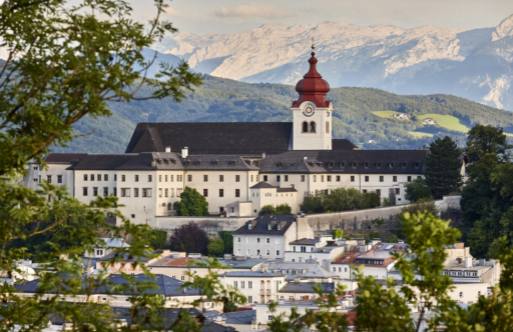Nestled atop the hills overlooking the charming city of Salzburg, Austria, lies the magnificent Hohensalzburg Fortress. With its towering walls and commanding presence, this medieval stronghold has stood the test of time and witnessed centuries of military and medieval history. From strategic military considerations to its significance as a symbol of power, Hohensalzburg Fortress remains a fascinating testament to Austria's rich past. Join us as we delve into the intriguing world of this historic landmark and uncover the secrets of its enduring legacy.

The Medieval Architecture of Hohensalzburg Fortress
The Hohensalzburg Fortress stands proudly atop the Festungsberg hill overlooking the city of Salzburg, Austria. This imposing structure is a prime example of medieval architecture, with its massive stone walls, sturdy towers, and intricate defensive features. The fortress's design incorporates both practical military considerations and ornate decorative elements, creating a formidable and visually striking presence in the landscape. Its strategic location and well-preserved medieval architecture make the Hohensalzburg Fortress a must-see destination for history enthusiasts and tourists alike.
The History of Hohensalzburg Fortress During the Middle Ages
Built in the 11th century by Archbishop Gebhard von Helfenstein, the fortress served as a symbol of the archbishop's power and authority. Over the centuries, the fortress was expanded and fortified, becoming one of the largest and most well-preserved fortifications in Europe.
Throughout the Middle Ages, Hohensalzburg Fortress was at the center of numerous conflicts and power struggles. It was besieged multiple times, with the most notable siege occurring in 1525 during the German Peasants' War. Despite these challenges, the fortress remained a formidable stronghold, serving as a crucial defense for the city of Salzburg.
In addition to its military importance, Hohensalzburg Fortress played a significant role in the cultural and intellectual life of the region during the Middle Ages. It housed a lavish residence for the archbishops, as well as a chapel and other important buildings. The fortress was also home to a garrison of soldiers and served as a center for administration and governance.
Overall, the history of Hohensalzburg Fortress during the Middle Ages is a testament to the power and influence of the archbishops of Salzburg. As a symbol of their authority and a strategic military stronghold, the fortress played a crucial role in shaping the history of the region during this turbulent period.
Defending Hohensalzburg: Strategic Military Considerations
Perched atop a hill overlooking the city of Salzburg, the fortress provided a strategic vantage point from which to spot approaching enemies and launch defensive measures. Its elevated positioning also made it difficult for adversaries to access and conquer the fortress.
The imposing walls of Hohensalzburg Fortress served as a formidable barrier against potential invaders. The thick stone walls were constructed with the intention of withstanding attacks from various forms of weaponry, including catapults and battering rams. Additionally, the fortress was equipped with watchtowers and battlements that allowed defenders to keep a lookout for any signs of enemy advancement.
In times of siege, Hohensalzburg Fortress had the advantage of being able to withstand a prolonged period of attack. The fortress was designed with self-sufficiency in mind, featuring storage facilities for food, water, and other essential supplies. This ensured that defenders could hold out against enemy forces for an extended period of time, waiting for reinforcements or relief.
Furthermore, Hohensalzburg Fortress was strategically positioned along major trade routes, allowing it to control and monitor the movement of goods and people in the region. This gave defenders an additional advantage in terms of intelligence gathering and resource management, ultimately contributing to the fortress's overall defensive capabilities.
Overall, the strategic military considerations that went into the design and location of Hohensalzburg Fortress played a significant role in its ability to withstand attacks and protect the city of Salzburg during the medieval period. The fortress stood as a testament to the power and ingenuity of medieval military architecture, serving as a symbol of strength and resilience in the face of adversity.
Hohensalzburg Fortress: A Symbol of Medieval Power
Hohensalzburg Fortress stands as a formidable symbol of medieval power, looming over the city of Salzburg with its imposing presence. Built on a hilltop overlooking the town, the fortress represents the strength and authority of the ruling elite during the Middle Ages. Its strategic location and massive stone walls served as a stark reminder of the might and dominance of those who controlled it.
Throughout the centuries, Hohensalzburg Fortress played a crucial role in asserting and maintaining power in the region. It served as a symbol of authority, a stronghold against enemies, and a center of administration for the ruling class. The grandeur and scale of the fortress conveyed a clear message of strength and control to those within its walls and beyond.
The architecture of Hohensalzburg Fortress reflects the military and political power of its time. Its thick walls, towers, and battlements were designed not only to defend against attacks, but also to project an image of invincibility. The fortress's strategic position overlooking the city allowed its occupants to monitor and control the surrounding area, further reinforcing their authority.
As a symbol of medieval power, Hohensalzburg Fortress continues to be a popular attraction for visitors from around the world. Its rich history and impressive architecture offer a glimpse into the past, when might was often equated with right. The fortress remains a testament to the enduring legacy of medieval rulers who sought to assert their dominance through architecture and military strength.
